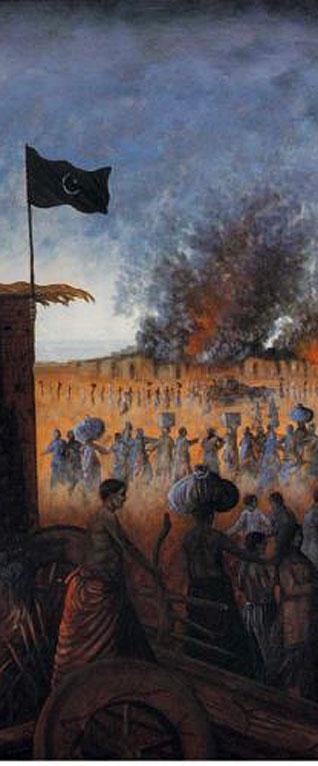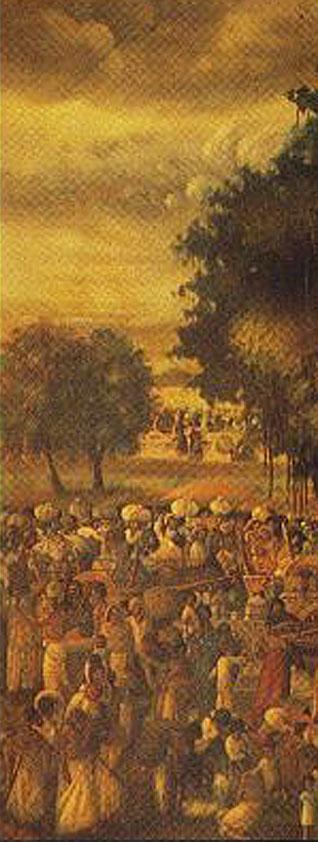Partition
The Partition & I:
Those Days of Insanity
by KHUSHWANT SINGH [New Delhi]
EDITOR: Sixty-two years have gone by since the cataclysmic events of 1947 - the Partition of Punjab and the loss of half of the Sikh homeland to newly created Pakistan - led to the sectarian violence that took a toll of more and a million lives and sent millions more as refugees in either direction of the haphazardly carved India-Pakistan border.
Many of those who have personal memories and knowledge of those days are now, because of the passage of time, moving on. It has therefore become urgent that we record their stories for the benefit of future generations.
Encouraged by the phenomenal response to our "1984 & I" project along the same lines, we at sikhchic.com once again turn to you, our readers, to share with us your memories, recollections, opinions and perspectives on 1947 and Partition. Please tell us how the Partition has touched your lives and how it has shaped your perspective on life. More importantly, please record the stories of aging parents, granparents, relatives, friends, colleagues, neighbours - and share them with us so that we in turn can publish them in these pages and, at the same time, create a permanent repository of the same.
We look forward to receiving your stories ... and photos. The following is the second piece of our new series, "THE PARTITION & I".
It was a day in mid-June, 1947, in Lahore - hot, still and silent. People were rudely shaken out of their siestas by shouts and exploding crackers.
Since March, their nights had been disturbed by sporadic gunfire and mobs yelling in the streets, hurling slogans like missiles. From one end, Muslims, armed with knives and lathis, shouted Naara-e-Takbeer, followed by full-throated Allah-O-Akbar.
From the other end came the reply, Bole-so-Nihal, Sat Sri Akal and Harhar Mahadev. Stones were thrown at each other, abuses exchanged and unwary pedestrians stabbed to death. The police fired to disperse mobs. A few people were killed before peace was restored.
The next morning, the papers reported the casualties like a ‘Muslims vs. The Rest' cricket score. The score was invariably in favour of Muslims. The chief reason for Muslims having the upper hand was that the umpires were Muslims. Over 80 per cent of Punjab Police was Muslim. The state government was Muslim-dominated.
It was the same story all over western Punjab. Sikhs and Hindus had begun pulling out of Muslim-dominated towns around Lahore, and finding Lahore equally unsafe, they trudged on to Amritsar and towns of eastern Punjab, where Sikhs and Hindus outnumbered Muslims.
That June afternoon of 1947 remains etched in my mind.
I had returned from the High Court when I heard the uproar. I ran up to the roof of my apartment. The sun burnt down fiercely over the city. From the centre billowed out a huge cloud of dense, black smoke. I did not have to make guesses.
The Sikh-Hindu mohalla of Shahalmi was going up in flames. Muslim goondas (thugs) had broken the back of non-Muslim resistance. After Shahalmi, the fight went out of the Sikhs and Hindus of Lahore. We remained mute spectators to Muslim League supporters matching in disciplined phalanxes, chanting Pakistan ka Naara Kya? La-ilaha-Lilillah.
The turmoil had little impact on the well-to-do who lived around Lawrence Gardens (today's Bagh-e-Jinnah), and on the either side of the canal, which ran on the eastern end of Lahore.
We went about in our cars to our offices, spent evenings playing tennis at the Cosmopolitan or the Gymkhana Club, had dinner parties where Scotch, which cost Rs 11 per bottle, flowed like waters of the Ravi.
In elite residential areas, the old bonhomie of Sikh-Muslim-Hindu bhai-bhai continued. We placed a lot of faith in the unionist government of Khizr Hayat Tiwana, who had Sikhs and Hindus in his Cabinet, and was strongly opposed to a separate Muslim state.
Muslim League leaders turned their ire on him. Processionists chanted Taazi khabar, mar gaya Khizr.
Then he threw in the sponge. Overnight he became the hero of Muslim sloganeers -Taazi khabar aayee hai, Khizr hamara bhai hai. The juggernaut gathered speed. Sikhs and Hindus began to sell properties and slip out towards eastern Punjab.
One day I found my neighbour on one side had painted in large Urdu calligraphy, Parsee ka makaan ("A Parsi‘s House). The other side had a huge cross painted in white. Unmarked Sikh and Hindu houses were thus marked out.
We were within walking distance of Mozang, centre of Muslim goondas.
By July, 1947, stories of retaliation against Muslims in east Punjab circulated in Lahore, and a trickle of Muslim refugees flew westwards.
This further roused Muslim fury. The last time I went to the High Court, I saw a dozen Sikh students of National College in handcuffs. They were charged with the murder of two Muslims on the Grand Trunk Road, running in front of their college. Among them was Ganga Singh Dhillon, later pioneer of the demand for Khalistan.
They were produced before Justice Teja Singh, the only Sikh Judge. He freed them on bail. That had become the pattern of justice.
A week before Independence (August 14-15), Chris Everett, head of the CID (Criminal Investigation Department) in Punjab, who had studied law with me in London, advised me to get out of Lahore.
Escorted by six Baluch constables, my wife and I took a train to Kalka to join our two children who had been sent ahead to their grandparents in Kasauli. Then I drove down to Delhi. There wasn't a soul on the 200-mile stretch.
I arrived in Delhi on August 13, 1947.
[Courtesy: The Tribune]
August 15, 2009
Conversation about this article
1: Harinder (Bangalore, India), August 15, 2009, 10:15 AM.
I don't know why we always have to be caught with our pants down ...






